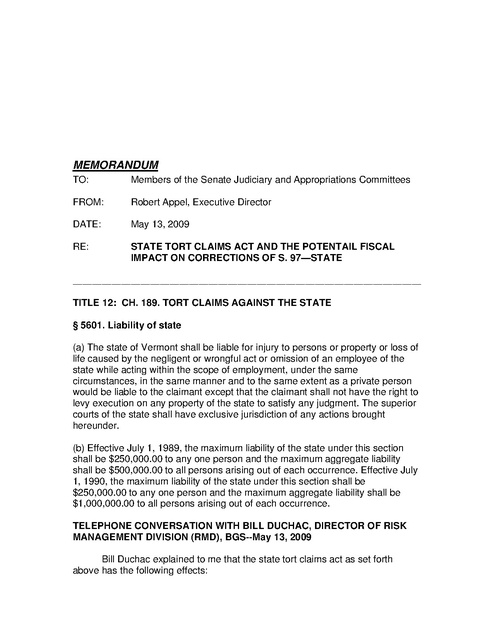Senate Judiciary State Tort Claims Act and Fiscal Impact on Corrections 2009
Download original document:

Document text

Document text
This text is machine-read, and may contain errors. Check the original document to verify accuracy.
MEMORANDUM TO: Members of the Senate Judiciary and Appropriations Committees FROM: Robert Appel, Executive Director DATE: May 13, 2009 RE: STATE TORT CLAIMS ACT AND THE POTENTAIL FISCAL IMPACT ON CORRECTIONS OF S. 97—STATE ________________________________________________________________________ TITLE 12: CH. 189. TORT CLAIMS AGAINST THE STATE § 5601. Liability of state (a) The state of Vermont shall be liable for injury to persons or property or loss of life caused by the negligent or wrongful act or omission of an employee of the state while acting within the scope of employment, under the same circumstances, in the same manner and to the same extent as a private person would be liable to the claimant except that the claimant shall not have the right to levy execution on any property of the state to satisfy any judgment. The superior courts of the state shall have exclusive jurisdiction of any actions brought hereunder. (b) Effective July 1, 1989, the maximum liability of the state under this section shall be $250,000.00 to any one person and the maximum aggregate liability shall be $500,000.00 to all persons arising out of each occurrence. Effective July 1, 1990, the maximum liability of the state under this section shall be $250,000.00 to any one person and the maximum aggregate liability shall be $1,000,000.00 to all persons arising out of each occurrence. TELEPHONE CONVERSATION WITH BILL DUCHAC, DIRECTOR OF RISK MANAGEMENT DIVISION (RMD), BGS--May 13, 2009 Bill Duchac explained to me that the state tort claims act as set forth above has the following effects: 1) The enactment waives any sovereign immunity defense up to the monetary limits set forth in the bill. 2) The enactment also sets for claims that fall within the scope of 12 V.S.A §5601(a), that is claims based on injury to persons or property based on a state cause of action, a hard or fixed cap of $1,000,000 to be paid as the “maximum aggregate liability … to all persons arising out of single occurrence.” 3) Claims brought pursuant to federal statutes, including the Americans with Disabilities Act or 42 U.S.C. §1983, fall outside the purview of the state tort claims act and the cap on liability does not apply. In addition, these enactments of Congress have been held to waive the states’ sovereign immunity defenses. 4) RMD manages a self insurance retention (SIR) pool to cover the first $250,000 of any claim against the State. The $250,000 is used to pay out settlement, judgments as well as cover the costs of litigation (hiring of expert witnesses, outside counsel, deposition costs and the like.) 5) Each agency, department, commission and board of state government pays a premium costs to support the SIR pool. The amount of the premium reflects the claims experience of the entity. The experience rating runs in 6 year cycles. So if an entity is found liable on a claim in year three, it will face increased premium costs in years four, five and six. However, year seven becomes year one and the premium charged to the entity returns to a base-line premium cost. 6) The state has purchased insurance to cover settlements and judgments that exceed the $250,000 limit of the SIR pool. 7) During Bill Duchac’s twenty plus years of service in RMD, there has never been a successful claim for punitive damages made against the State of Vermont. These claims have, on occasion, been submitted to juries, but no such punitive damage award has been made. 8) Bill Duchac reported that in the years 2001-2006, the total aggregate amount paid out of the SIR pool on all claims made against the Department of Corrections equaled $1,350,000, or $270,000 per year. This average annual cost is $20,000 more than a single maximum SIR pool payment of $250,000. 9) Bill Duchac also reported that DOC is not expected to pay dollar for dollar on each of these pay-outs, but does face the six year cycle of premium adjustments.

